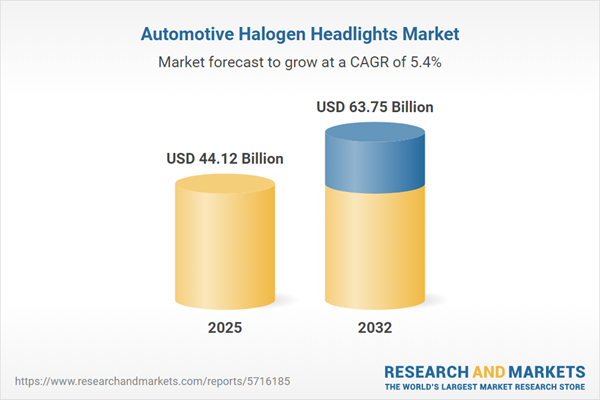Speak directly to the analyst to clarify any post sales queries you may have.
The automotive halogen headlights market remains a consistent anchor in global vehicle lighting, offering organizations reliable performance and streamlined supply chains for fleets and OEM platforms worldwide. Whether maintaining established operations or considering new procurement initiatives, halogen headlights continue to meet regulatory demands and evolving industry needs.
Market Snapshot: Automotive Halogen Headlights Market
As of 2024, the global automotive halogen headlights market is valued at USD 41.88 billion, with projections indicating USD 44.12 billion by 2025 and USD 63.75 billion by 2032. This represents a robust CAGR of 5.39%, highlighting ongoing relevance even as LED and alternative lighting solutions emerge. Sustained demand for automotive halogen headlights arises from ongoing technical upgrades and adherence to increasingly stringent safety standards, fostering predictable procurement schedules. Market stability is reinforced by the widespread regulatory acceptance of halogen technology, making it a dependable choice for both established and emerging economies. Manufacturers and procurement leaders benefit from a mature, globalized market landscape that enables efficient logistical planning and risk diversification.
Scope & Segmentation
This report provides a focused, end-to-end analysis to support leaders making decisions about supply chain management, regulatory compliance, and operational strategy in the automotive halogen headlights sector. Segmentation is organized to help benchmark, assess risk, and refine procurement processes:
- Technology Types: High Performance Halogen and Standard Halogen categories deliver options for different illumination strengths, operating lifecycles, and ease of integration, addressing both OE and aftermarket requirements for flexible deployment.
- Distribution Channels: Direct dealership procurement, maintenance workshops, and online platforms expand purchasing options, supporting traditional bulk buyers as well as organizations using digital procurement for improved inventory control.
- Vehicle Applications: Solutions cover commercial fleets, passenger vehicles, heavy-duty trucks, off-road machinery, and specialty models for agriculture and construction, ensuring supply and demand resilience across multiple sectors.
- Geographical Regions: The Americas, Europe, Middle East, Africa, and Asia-Pacific each offer unique regulatory landscapes and adoption patterns, influencing both certification cycles and continuity of product delivery.
- Key Industry Participants: Leading manufacturers and suppliers include OSRAM GmbH, Koninklijke Philips N.V., HELLA GmbH & Co. KGaA, Koito Manufacturing Co., Ltd., Stanley Electric Co., Ltd., Marelli Holdings Co., Ltd., Varroc Engineering Ltd., ZKW Group GmbH, Lumileds LLC, and Robert Bosch GmbH, setting standards for product consistency and supply chain transparency.
This segmentation offers actionable benchmarks for operational performance and empowers decision-makers to stay adaptable in response to shifting regulatory or technological developments.
Key Takeaways for Senior Decision-Makers
- Halogen headlights offer stable and predictable procurement, facilitating seamless integration with new models and simplifying ongoing maintenance cycles.
- Continuous improvements in filament and gas technology enhance product longevity, helping organizations minimize disruptions due to headlight replacement and repair.
- Diversified sourcing and supplier networks help build resilience against raw material shortages, supporting sustainability initiatives within automotive lighting supply chains.
- Halogen solutions maintain compatibility with vehicle safety and management systems, supporting connected vehicle strategies and fleet modernization goals.
- Multiple procurement channels—including e-commerce—equip organizations with faster access to inventory and expanded options for global aftermarket operations.
- Partnering with established manufacturers enables organizations to anticipate regulatory change and reduce the risk of disruption due to evolving legal mandates.
Tariff Impact: Navigating U.S. Trade Measures
Forthcoming U.S. tariff adjustments in 2025 are prompting organizations to adapt by broadening sourcing options, investing in distributed production infrastructure, and pursuing greater vertical integration. These strategies help maintain cost structures and keep product flow stable despite ongoing policy shifts, allowing leaders to sustain operational efficiency under new trade dynamics.
Methodology & Data Sources
Findings in this report are developed through a blend of comprehensive secondary research and direct input from industry leaders, procurement managers, and technical specialists. This approach captures current industry risks, trends in innovation, and regulatory themes that directly influence the automotive halogen headlights market.
Why This Report Matters
- Senior leadership can synchronize risk management and investment strategies with emerging standards and compliance requirements in vehicle lighting.
- Procurement teams gain foresight on market trends, enabling proactive responses to trade shifts while maintaining uninterrupted supply in complex regions.
- The analysis empowers organizations to adopt flexible sourcing and inventory practices, providing the agility to respond to regulatory or supplier disruptions efficiently.
Conclusion
Automotive halogen headlights remain a dependable choice for organizations seeking robust supply chains and operational adaptability. The insights provided equip decision-makers to address the ongoing transitions shaping the global vehicle lighting landscape.
Additional Product Information:
- Purchase of this report includes 1 year online access with quarterly updates.
- This report can be updated on request. Please contact our Customer Experience team using the Ask a Question widget on our website.
Table of Contents
3. Executive Summary
4. Market Overview
7. Cumulative Impact of Artificial Intelligence 2025
Companies Mentioned
The companies profiled in this Automotive Halogen Headlights market report include:- OSRAM GmbH
- Koninklijke Philips N.V.
- HELLA GmbH & Co. KGaA
- Koito Manufacturing Co., Ltd.
- Stanley Electric Co., Ltd.
- Marelli Holdings Co., Ltd.
- Varroc Engineering Ltd.
- ZKW Group GmbH
- Lumileds LLC
- Robert Bosch GmbH
Table Information
| Report Attribute | Details |
|---|---|
| No. of Pages | 187 |
| Published | October 2025 |
| Forecast Period | 2025 - 2032 |
| Estimated Market Value ( USD | $ 44.12 Billion |
| Forecasted Market Value ( USD | $ 63.75 Billion |
| Compound Annual Growth Rate | 5.3% |
| Regions Covered | Global |
| No. of Companies Mentioned | 11 |









